If you want to know about the scale and proportion in architecture or design consideration for HVAC or installation of split air conditioners, please click the link.
A central air conditioning system is a type of air conditioning system that uses a network of ducts to cool and dehumidify the air in an entire building or home. It is often used in larger homes, commercial buildings, and other facilities where individual room air conditioning units are not practical or cost-effective.
- The conditioning process takes place outside the place is to be conditioned.
- Air is conditioned in a plant and an air handle may be provided circulate air and duct are used to distribute conditioned air to the different spaces to be conditioned.
- In addition to the compressor, condenser, evaporator, and the motor the plant usually includes filter for cleaning the air, fans for cleaning the air, grills for discharging the air louvers for fresh air intake, auxiliary heat air exchanger to transfer heat from chilled water to air (when air is used and cooling towers when water is used) cooled condenser, pumps, damps, valves, and controls are often essentials.
1) Direct expansion system
- In the direct expansion or DX types of air central conditioning plants the air used for cooling space is directly chilled by the refrigerant in the cooling coil of the air handling unit.
- Since the air is cooled directly by the refrigerant the cooling efficiency of the DX plants is higher.
- However, it is not always feasible to carry the refrigerant piping to the large distances hence, direct Expansion or the DX type of central air conditioning system is usually used for cooling the small buildings or the rooms on the single floor.
i) The Plant Room

- The plant room comprises of the important parts of the refrigeration system, the compressor and the condenser.
- The compressor can be either semi-hermetically sealed or open type.
- The semi-hermetically sealed compressors are cooled by the air, which is blown by the fan, while open type compressor is water cooled.
- The open compressor can be driven directly by motor shaft by coupling or by the belt via pulley arrangement.
- The condenser is of shell and tube type and is cooled by the water.
- The refrigerant flows along the tube side of the condenser and water along the shell side, which enables faster cooling of the refrigerant.
- The water used for cooling the compressor and the condenser is cooled in the cooling tower kept at the top of the plant room, though it can be kept at other convenient location also.
ii) The Air Handling Unit Room
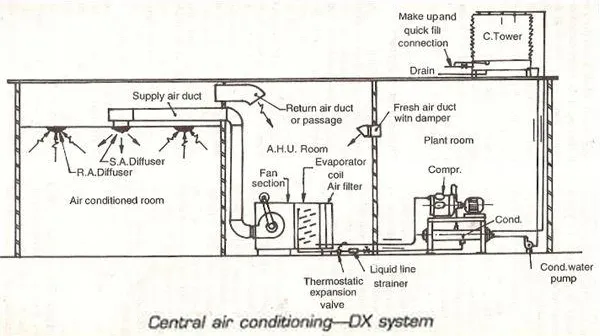
- The refrigerant leaving the condenser in the plant room enters the thermostatic expansion valve and then the air handling unit, which is kept in the separate room.
- The air handling unit is a large box type of unit that comprises of the evaporator or the cooling coil, air filter and the large blower.
- After leaving the thermostatic expansion valve the refrigerant enters the cooling coil where it cools the air that enters the room to be air conditioned. The evaporator in the air handling unit of the DX central air conditioning system is of coil type covered with the fins to increasing the heat transfer efficiency from the refrigerant to the air.
- There are two types of ducts connected to the air handling unit: for absorbing the hot return air from the rooms and for sending the chilled air to the rooms to be air conditioned.
- The blower of the air handling unit enables absorbing the hot return air that has absorbed the heat from the room via the ducts. This air is then passed through the filters and then over the cooling coil.
- The blower then passes the chilled air through ducts to the rooms that are to be air conditioned.
2) Chilled water system
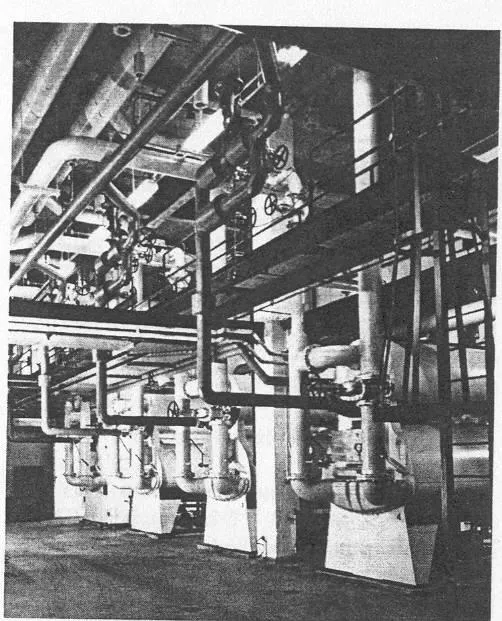
This system is also known as all water system. In this medium of cooling is chilled water. Water or Brine is passed over the evaporator coil in which water is cooled. The unit containing the vapour coil in which water is cooled is known as chiller. Chilled water from the chillers is pumped into the cooling coil provided in the AHU
- The air to be cooled is passed over the cooling coil thus cooled.
- The cooled air is finally applied to space to be air conditioned through ducts.
- In this system the temperature of the room is varied or controlled by varying the quantity of water flowing through the cooling coil in the terminal units as the load varies.
- Chilled water is usually distrusted through two systems. One pipe supplied the chilled water the other takes the chilled water back to the central plant.
- This system is used when 100 tonne or more refrigeration is required.
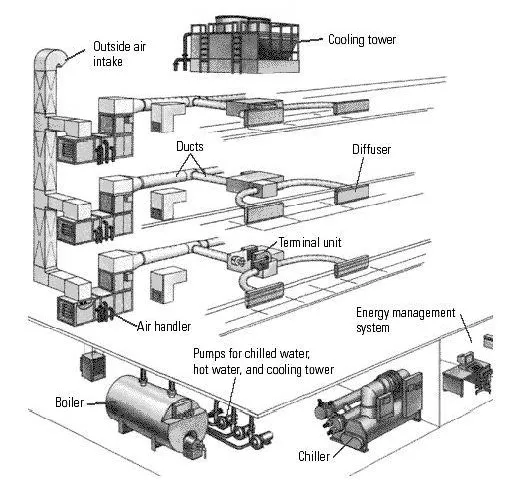

i) AC plant room
- The plant room comprises of all the important components of the chilled water air conditioning plant. These include the compressor, condenser, thermostatic expansion valve and the evaporator or the chiller. The compressor is of open type and can be driven by the motor directly or by the belt via pulley arrangement connected to the motor. It is cooled by the water just like the automotive engine.
- The evaporator is also called as the chiller, because it chills the water. The water chilled in the chiller is pumped to various parts of the building that are to be air conditioned. It enters the air handling unit, cools the air in cooling coil, absorbs the heat and returns back to the plant room to get chilled again. The amount of water passing into the chiller is controlled by the flow switch.
- AC plant room is a room to accommodate the machine for the air conditioning process. Either air processing or cooling process takes place in a plant room. LP, LT refrigerant that comes from the evaporator is converted to HP, HT in the compressor that is than liquefied at the same pressure in the condenser and send back to the evaporator coil (in the AHU). The parts located in the AC plant room are endorser compressor, receiver & the evaporator. In case of the chilled water system evaporator is located in the AHU.

Requirements
- Plant room should be totally enclosed should have artificial lights & mechanical ventilation.
- It should be acoustically treated.
- The area for a plant room for 100-tonn capacities should be about 100m².
- The min ht. for the plant room should be 4.1m.
- An independent exit should be provided. Emergency light and exit should also be provided.
- Ramps, hoists and cut outs should be provided for the machine to be taken out from the repairing
- Special consideration should be made for the foundation special pile or special rafter should be provided.
- The foundation should be such to sustain the 2.5 times the operating wt of the machine.
- The machine should be raised 6` above from the floor.
- Cooling tower is required when water-cooled condenser is used.
ii) Air Handling Unit Rooms
- The air handling units are installed in the various parts of the building that are to be air conditioned, in the place called air handling unit rooms. The air handling units comprise of the cooling coil, air filter, the blower and the supply and return air ducts.
- The chilled water flows through the cooling coil. The blower absorbs the return hot air from the air-conditioned space and blows it over the cooling coil thus cooling the air. This cooled air passes over the air filter and is passed by the supply air ducts into the space which is to be air conditioned. The air handling unit and the ducts passing through it are insulated to reduce the loss of the cooling effect.
- This unit is provided with 2 inlets, one for fresh air intake & another for return air from the conditioning spares.
- When the return air mixing with 10% of the fresh air first passing over the filter passes over the evaporator coils the refrigerant absorbs the heat.
- As a result cold airs are blown out by the blower present in the AHU, which distribute the air.
- The used air is again return to this unit.

- In case of chilled water system instead of evaporator coil filled with refrigerant chilled water coil is present in AHU.
Function
Clean, cool, circulate & re circulate the air.
Components
- Filter to remove dust.
- Cooling coil for cooling the air.
- Blower to pressurise the air passing through the duct.
Requirements
- Chilled water is required. Drainage should be provided and fresh air from outside is required
- One AHU can serve an area of 475 sq meters.
- The area of AHU room should be around 20 sq meters and the maximum length of duct from AHU room should be 30-40m.
- Only the AHU panels should be provided and other panel should be placed outside the room.
iii) Air-Conditioned Rooms
- These are the rooms or spaces that are to be air conditioned.
- These can be residential or hotel rooms, halls, shops, offices, complete theater, various parts of the airport etc. At the top of these rooms the supply and the return air ducts are laid.
- The supply air ducts supply the cool air to the room via one set of the diffusers, while the return air ducts absorb the hot return air from the room by another set of the diffusers.
- The hot return air enters the air handling unit, gets cooled and again enters the room via supply duct to produce air conditioning effect.
iv) Fan Coil Unit
- This provides individually room controls. This is small scale AHU.
- It consists of water coil to cool the air, Fan for blowing room air over the coil, Enclosure for the equipment, controls for fan speed & water flow.
- FCU may be floor mounted or placed under corridor recessed in ceiling and connected through ducts.
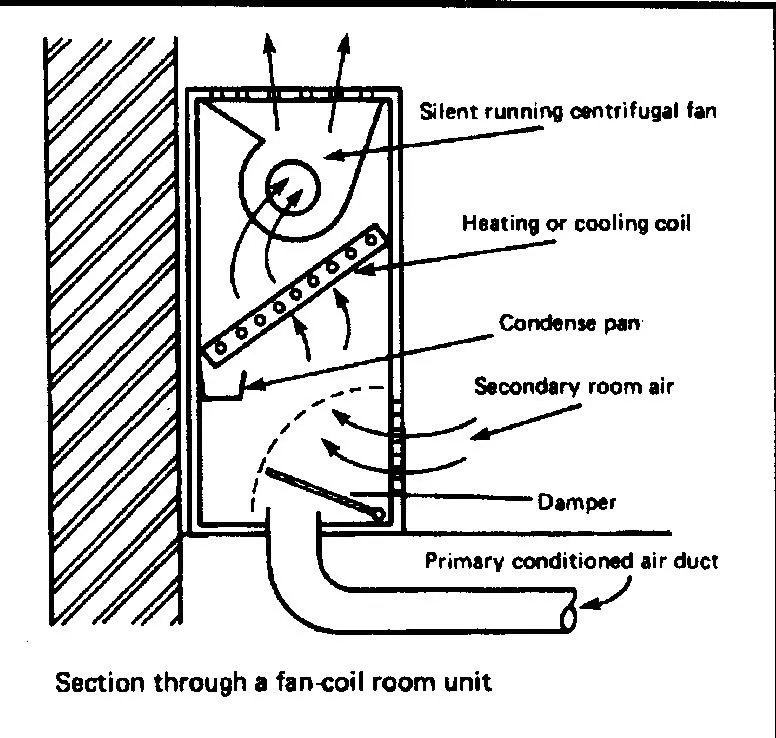
Requirements
- The minimum size of FCU is one meter long and three meter deep.
- For fire prevention, pressure in the room should be kept lower
v) Cooling tower
- Cooling tower is in the AC system where water-cooled condenser is used.
- The condenser water removes heat from the high temperature refrigerant and temperature is raised.
- The purpose of cooling tower is to dispose heat gained by the water.
- In the cooling tower water is sprayed into the air from the top.
- In dropping downward through the tower, it comes in contact with the air.
- The air picks ups heat from the water and carries heat into the atmosphere, some of the water is evaporated and reminder is cooled.
- The cooled water is collected at the base of the tower.
- The pumps circulate the water through the cooled condenser.
Water cooled condenser
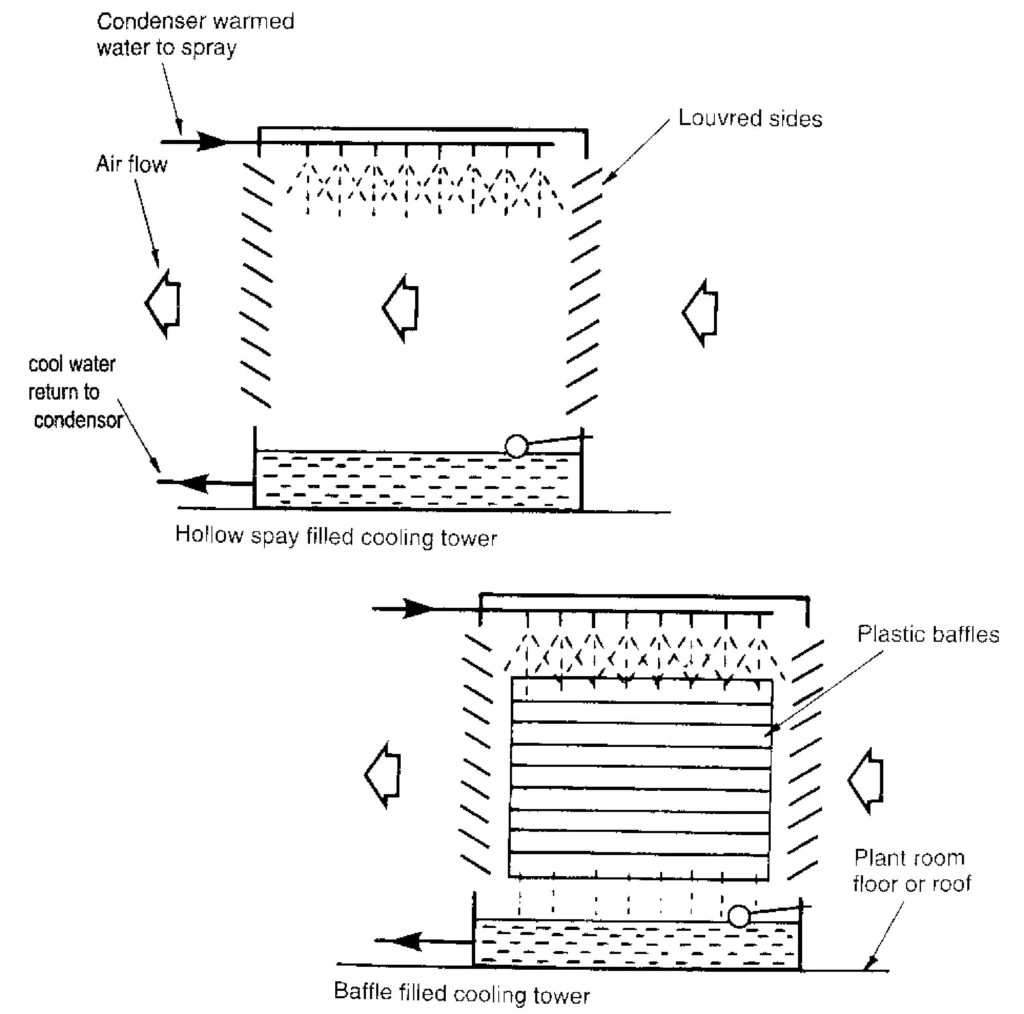
Air cooled condenser
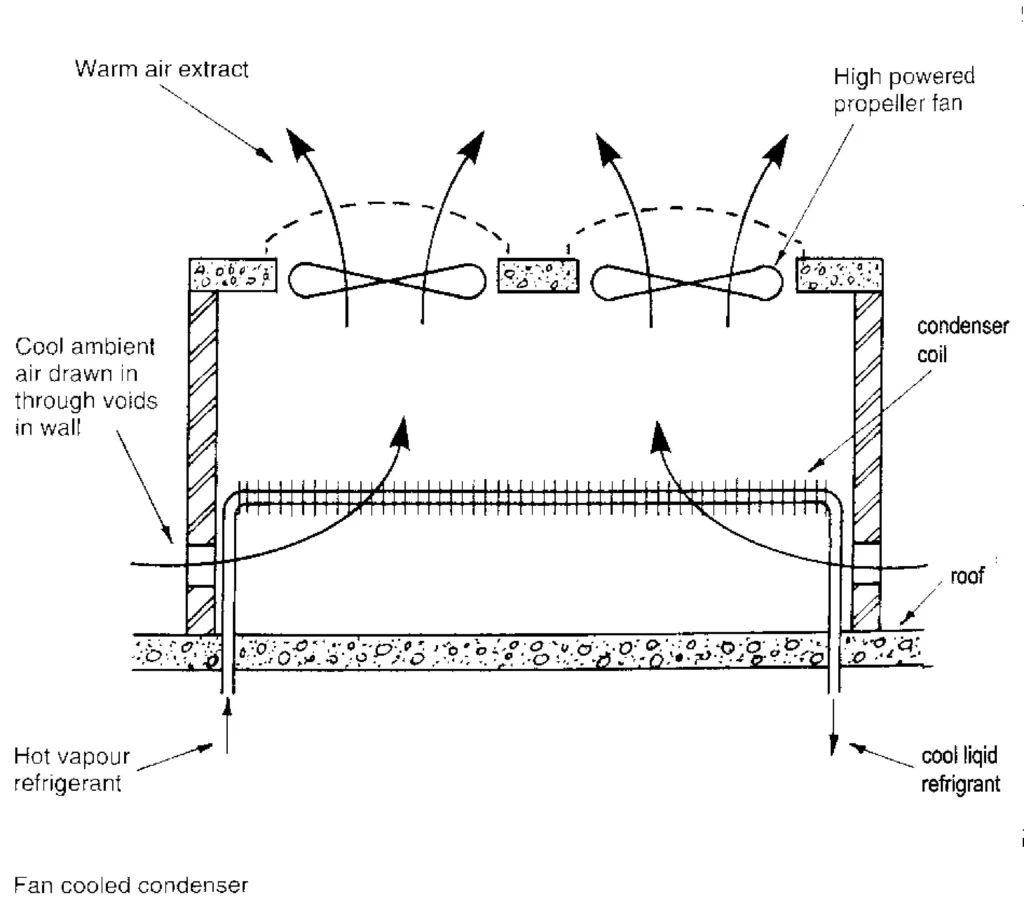
Central air conditioning systems are often controlled by a thermostat, which allows the user to set the desired temperature and control the system’s operation. Modern central air conditioning systems can be highly efficient and cost-effective, and they can be customized to meet the specific needs of different buildings and environments.